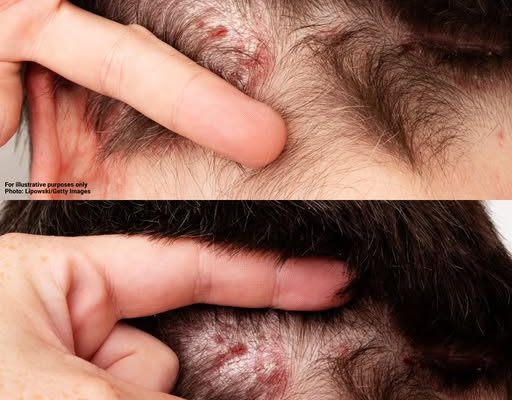In this article, we will explore various scalp conditions, focusing on psoriasis vulgaris, a common yet often misunderstood condition. We’ll provide insights into identifying and managing scalp psoriasis at home, suggest over-the-counter treatments, and offer tips on when to seek medical attention. Additionally, we’ll discuss how to document symptoms effectively for your doctor and share online resources and support groups that can offer further assistance.

1. Understanding Scalp Conditions: A Brief Overview
The scalp is a complex area of the body, hosting a variety of conditions that can manifest as bumps, lesions, or irritations. These conditions can range from benign issues like dandruff to more serious concerns such as infections or chronic skin disorders. Understanding the nature of these conditions is crucial for effective management and treatment.
Scalp conditions can be caused by a variety of factors, including genetics, environmental influences, and personal hygiene practices. For instance, seborrheic dermatitis, a common scalp condition, is characterized by flaky scales and redness and is often linked to an overgrowth of yeast on the skin. Similarly, folliculitis, an infection of the hair follicles, can result in red, pus-filled bumps. Accurate identification of these conditions is essential for determining the appropriate course of action.
2. Common Causes of Scalp Bumps
Scalp bumps can arise from numerous causes, each with distinct characteristics. One prevalent cause is seborrheic dermatitis, which presents as greasy, yellowish scales and is often accompanied by itching. Another common cause is folliculitis, where hair follicles become inflamed due to bacterial or fungal infections, resulting in small, red bumps that may be tender to the touch.
Additionally, cysts, such as pilar cysts, can develop on the scalp. These are typically benign, fluid-filled sacs that form under the skin and can vary in size. Psoriasis, a chronic autoimmune condition, can also cause raised, red patches covered with silvery scales. Understanding these causes can help in narrowing down the potential condition affecting your child.

3. Psoriasis Vulgaris: What You Need to Know
Psoriasis vulgaris, the most common form of psoriasis, is a chronic autoimmune disorder that affects the skin, including the scalp. It occurs when the immune system mistakenly attacks healthy skin cells, leading to rapid cell turnover and the formation of thick, scaly patches. These patches can be itchy, painful, and may crack and bleed.
Psoriasis is a multifactorial condition, influenced by genetic predisposition and environmental triggers such as stress, infections, and certain medications. While there is no cure, various treatments can help manage symptoms and improve quality of life. Understanding the nature of psoriasis vulgaris is essential for effective management and treatment.
4. Identifying Psoriasis on the Scalp
Scalp psoriasis is characterized by raised, reddish patches covered with silvery-white scales. These patches can extend beyond the hairline and may be accompanied by itching, burning, or soreness. In some cases, scalp psoriasis can cause temporary hair loss due to scratching or the presence of thick scales.
To identify psoriasis on the scalp, look for well-defined plaques that are distinct from the surrounding skin. These plaques can vary in size and may appear in isolated patches or cover large areas of the scalp. It’s important to differentiate scalp psoriasis from other conditions like seborrheic dermatitis, which tends to have a more diffuse, greasy appearance.

5. Home Remedies for Scalp Psoriasis
Several home remedies can help alleviate the symptoms of scalp psoriasis. One effective approach is the use of moisturizing agents, such as coconut oil or aloe vera gel, to soothe dryness and reduce scaling. Applying these agents to the scalp and leaving them on for several hours or overnight can help soften scales and ease discomfort.
Another remedy is the use of apple cider vinegar, which has natural antiseptic properties. Diluting it with water and applying it to the scalp can help reduce itching and inflammation. Additionally, regular exposure to sunlight, while protecting the skin from UV damage, can help slow down the rapid skin cell turnover associated with psoriasis.
6. Over-the-Counter Treatments to Consider
Over-the-counter (OTC) treatments can be beneficial for managing mild to moderate scalp psoriasis. Shampoos containing coal tar or salicylic acid are commonly used to reduce scaling and inflammation. Coal tar helps slow skin cell growth, while salicylic acid aids in the removal of scales.
Topical corticosteroids, available in various strengths, can also be effective in reducing inflammation and itching. It’s important to follow the instructions on these products carefully and consult with a pharmacist if you have any questions. Consistent use of these treatments can help manage symptoms and prevent flare-ups.
7. When to Seek Medical Attention
While home remedies and OTC treatments can provide relief, it’s important to seek medical attention if your child’s scalp condition worsens or does not improve with self-care measures. Persistent symptoms, such as severe itching, pain, or extensive scaling, warrant a professional evaluation.
Additionally, if your child experiences signs of infection, such as increased redness, swelling, or pus, it’s crucial to consult a healthcare provider promptly. A dermatologist can provide a definitive diagnosis and recommend prescription treatments tailored to your child’s specific needs.

8. Tips for Managing Scalp Psoriasis at Home
Managing scalp psoriasis at home involves a combination of lifestyle adjustments and consistent treatment. Regularly moisturizing the scalp can help prevent dryness and reduce scaling. Using a humidifier in your home can also maintain moisture levels in the air, which can benefit the skin.
It’s important to avoid triggers that can exacerbate psoriasis, such as stress, smoking, and certain foods. Keeping a diary to track flare-ups and identify potential triggers can be helpful. Additionally, gentle hair care practices, such as using a soft-bristle brush and avoiding harsh hair treatments, can prevent irritation and minimize hair loss.
9. Viral Hacks for Scalp Care
In recent years, several viral hacks for scalp care have gained popularity, offering alternative approaches to managing scalp conditions. One such hack is the use of tea tree oil, known for its antifungal and anti-inflammatory properties. Adding a few drops to your regular shampoo can help soothe the scalp and reduce dandruff.
Another popular hack is the use of baking soda as a gentle exfoliant. Mixing it with water to form a paste and applying it to the scalp can help remove dead skin cells and reduce scaling. However, it’s important to use these hacks with caution and conduct a patch test to ensure there is no adverse reaction.
10. How to Document Symptoms for Your Doctor
Documenting symptoms effectively can aid in obtaining an accurate diagnosis and treatment plan from your doctor. Keep a detailed record of your child’s symptoms, including the onset, duration, and severity of any bumps, itching, or scaling. Note any potential triggers or changes in your child’s routine that may have contributed to flare-ups.
Photographs can also be a valuable tool for documenting changes over time. Take clear, well-lit photos of the affected areas at regular intervals to track progress or worsening of the condition. Bringing this documentation to your doctor’s appointment can provide valuable insights and assist in developing a tailored treatment plan.
11. Online Resources and Support Groups
Navigating a scalp condition can be challenging, but online resources and support groups can offer valuable information and emotional support. Websites such as the National Psoriasis Foundation provide comprehensive resources on managing psoriasis, including treatment options and lifestyle tips.
Joining online support groups or forums can connect you with others who are experiencing similar challenges. These communities offer a platform to share experiences, ask questions, and receive encouragement from individuals who understand what you’re going through. Engaging with these resources can help you feel less isolated and more empowered in managing your child’s condition.


